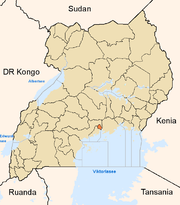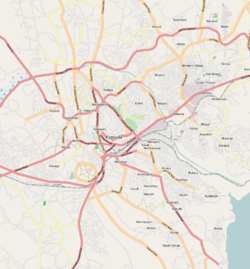- Namirembe hill
-
Namirembe Map of Kampala showing the location of Namirembe Coordinates: 00°18′54″N 32°33′34″E / 0.315°N 32.55944°E Country  Uganda
UgandaRegion Central Uganda District Kampala Capital City Authority Division Lubaga Division Elevation 1,260 m (4,134 ft) Time zone EAT (UTC+3) Namirembe is a hill in Kampala, Uganda's capital and largest city. It is also a common name given to girls in several Baganda clans. Namirembe comes from the Luganda word “mirembe” meaning “peace”. Namirembe loosely translates into Full of Peace. Legend has it that this hill was a gathering place for celebrating peace or war victory.[1]
Contents
Location
Namirembe is bordered by Makerere to the northeast, Old Kampala to the east, Mengo to the southeast, Lubaga to the southwest, Lungujja to the west, Kasubi to the northwest and Naakulabye to the north. The coordinates of Namirembe Hill are:00 18 54N, 32 33 34E (Latitude:0.3150; Longitude:32.5595). The distance, by road, from the central business district of Kampala to Namirembe is approximately 2 kilometres (1.2 mi).
Anglican Churches and Cathedral
Namirembe Hill has been the location of the main Anglican place of worship in Buganda since Bishop Alfred Tucker established the offices of the Diocese of Eastern Equatorial Africa in 1890. Tragedy befell the first four church structures:
- The first church building, constructed in 1890, with a capacity of 800 people, was abandoned in 1891 because it was located in a swampy area at the base of Namirembe Hill. Also, a bigger building was needed to accommodate the ever-growing congregation.
- The second church building was constructed between July 1891 and July 1892, with a seating capacity of more than 3,000. In October 1894, strong winds during a thunderstorm blew the roof off the church and it was ruined.
- The third church building was built between 1894 and 1895. It had a seating capacity of about 4,000 worshippers. That building, constructed with traditional African materials, was abandoned in the early 1900s due to fear that termites would destroy it.
- The fourth church building was constructed with earthen brick walls and a thatched roof, between 1900 and 1904. At the opening ceremony, on Tuesday 21 June 1904, an estimated 10,000 people were in attendance. The congregation included Kabaka Daudi Chwa II, then aged seven. On the afternoon of Friday 23 September 1910, the roof was gutted by a fire which started when lightning struck the building. Within less than thirty minutes, the entire roof was destroyed and the church was ruined.
- The current St. Paul's Cathedral was constructed between 1915 and 1919 using earthen bricks and earthen roof tiles. The cathedral is still standing, while needing repairs from time to time.
The Organ in St Paul's Cathedral Namirembe (The Mother & Provincial Cathedral of the Church of Uganda, Anglican Communion) was built in 1931 by The Positive Organ Co. (1922) Ltd. After twenty years of service the organ was in need of an overhaul and this work was entrusted to Alfred E. Davis of Northampton in 1952. The organ gave a further twenty years of service, but after Idi Amin seized power in 1971 it deteriorated seriously during the years of unrest and there was little chance of any reparation. Eventually in 1998 Peter Wells from England was sent for to inspect what remained and advise on the rehabilitation. Several schemes were considered and the organ today operates to a specification drawn up with the late Michael Sozi (then Chairman of the Organ Committee) in 1999:
Great: Bourdon 16, Open Diapason 8, Dulciana 8, Clarabella 8, Principal 4, Mixture 15:19/12:15 II,
Swell: Viola da Gamba 8, Gedeckt 8, Gemshorn 4, Piccolo 2, Contra Oboe 16, Trumpet 8,
Pedal: Open Diapason 16, Bourdon 16, Octave 8, Trombone 16,
Due to limited funds, it was decided to stagger the work of restoration. The first phase commenced after Easter 1999 when Peter & Ann Wells travelled to Uganda to install new manual keyboards and action to the manual soundboards. The full scheme was realised in 2006/7 with the installation of the Great Mixture and Pedal Trombone.
Overview
The hill rises 4,134 feet (1,260 m) above sea level. It stands adjacent to Mengo Hill, the seat of the Buganda Government. The history of the two hills is intertwined, geographically, politically and religiously.
Namirembe is the location of St. Paul's Cathedral, the main place of worship of the Anglican Church in Uganda, from the time of its construction (1915 to 1919), until the 1960's when the Cathedral became the seat of the Diocese of Namirembe. At that time, the headquarters of the Church of Uganda moved to All Saints Church in Nakasero. The Anglican Faith is the religion most closely associated with the Buganda Monarchy since the end of the religious wars of the 1890s.
Mengo Hospital (also known as Namirembe Hospital), the first hospital in Uganda, was started by Sir Albert Ruskin Cook in May 1897. At the northwestern base of Namirembe Hill are the Buganda royal burial grounds known as Kasubi Tombs. It is here, that the kings of Buganda are buried.
The Bulange, Buganda’s parliament building is also situated on Namirembe Hill, just across from Mengo hill. The Mengo Palace on Mengo Hill is connected to the Bulange on Namirembe Hill by a straight road, about a mile long, called Kabaka Anjagala Road (The King Loves Me). About halfway, the straight road is intersected by Lubaga Road. There is a roundabout for the use of ordinary travelers. However, there is a strait-way through the roundabout with a gate. That is for the exclusive use of the Kabaka when moving between the palace and the parliament building. Tradition forbids the king from going round the roundabout. He must travel straight when moving between the two locations.
Landmarks
Landmarks on Namirembe Hill or near the hill include:
- St. Paul's Cathedral - The most prominent place of worship in the Anglican Church in Uganda
- Residence of the Archbishop of the Church of Uganda
- Residence of the Bishop of Namirembe Anglican Diocese
- Sanyu Babies Home - An Orphanage managed by a private NGO
- Mengo Hospital - A 300 community hospital affiliated with the Church of Uganda
- The Bulange Complex - The parliamentary building that houses the parliament of Buganda, known as the Lukiiko and the offices of the Kabaka of Buganda.
External links
See also
References
Kampala District Capital: Kampala Divisions Neighborhoods Bugoloobi · Bukoto · Busega · Butabika · Bwaise · Ggaba · Kabalagala · Kamwookya · Kansanga · Kaleerwe · Kanyanya · Kasubi · Katwe · Kawaala · Kawempe · Kibuli · Kibuye · Kigoowa · Kikaaya · Kisaasi · Kiwaatule · Kulambiro · Kololo · Kyambogo · Kyebando · Lubaga · Lungujja · Luzira · Makerere · Makindye · Mbuya · Mengo · Mpererwe · Mulago · Munyonyo · Mutundwe · Muyenga · Naakulabye · Naguru · Najjanankumbi · Nakasero · Nakawa · Namirembe · Namungoona · Namuwongo · Nateete · Ndeeba · Nsambya · Ntinda · Old Kampala · Port Bell · Wandegeya 
Economy Air Uganda · Aya Group · Quality Chemical Industries Limited · Mukwano Group · Ruparelia Group · Bank of Uganda · ABC Capital Bank · Bank of Africa · Bank of Baroda · Barclays Bank · DFCU Group · Cairo International Bank · Centenary Bank · Citibank · Crane Bank · DFCU Bank · Diamond Trust Bank · Ecobank · Equity Bank · Fina Bank · Global Trust Bank · Housing Finance Bank · Imperial Bank Uganda · Kenya Commercial Bank · National Bank of Commerce · Orient Bank · PostBank Uganda · Stanbic Bank · Standard Chartered Bank · Tropical Bank · United Bank for Africa · East African Development Bank · Uganda Development Bank · National Housing and Construction Company · Uganda Air Cargo · International Medical Group · National Social Security Fund · Umeme · Uganda Securities Exchange · Uganda Investment Authority · Capital Markets Authority · The Monitor · New Vision · New Vision Group · Uganda Telecom · Mercantile Credit Bank · Pride Microfinance Limited · Uganda Finance Trust Limited · Opportunity Uganda Limited · Kyagalanyi Coffee Limited · FINCA Uganda Limited · UGAFODE Microfinance LimitedNotable
landmarksBulange · Uganda Parliament Buildings · Butabika National Referral Hospital · Mulago Hospital Complex · Nsambya Hospital · Rubaga Hospital · Mengo Hospital · International Hospital Kampala · Kibuli Hospital · Kampala Capital City Authority Complex · Kampala Serena Hotel · Hotel Africana · Kampala Sheraton Hotel · Imperial Hotels Group · Imperial Royale Hotel · Grand Imperial Hotel · Hotel Equatoria · Kampala Hilton Hotel · Kampala Intercontinental Hotel · Kampala Speke Hotel · East African Development Bank Building · Bank of Uganda Building Complex · Mengo Palace · St. Paul's Cathedral Namirembe · St. Mary's Cathedral Lubaga · Makerere University Main Campus · Kibuli Mosque · Old Kampala Mosque · Kampala Airport · Uganda Museum · Uganda National Cultural Centre · Kampala Northern Bypass Highway · Kampala-Jinja Highway · Kasubi Tombs · Roman Catholic Archdiocese of KampalaEducation Makerere University · Makerere University Business School · Kampala International University · Kampala University · Kyambogo University · Law Development Centre · International Health Sciences University · International University of East Africa · Makerere College School · Rubaga Community School · Saint Lawrence University · Uganda Management Institute · Victoria University UgandaNotable people Apolo Nsibambi · Nasser Ntege Sebaggala · David Serwadda · Fred Ruhindi · John Ssebaana Kizito · Bulaimu Muwanga Kibirige · Erias Lukwago · Dr. Ian Clarke · Jennifer Musisi · Maria Kiwanuka · Laurence Sematimba · Joseph Kizito · Justinian Tamusuza · Robert Ssejjemba · Eugene Sseppuya · Phillip Ssozi · Wasswa Serwanga · Yusef Sozi · Derrick SebagalaCategories:- Neighborhoods of Kampala
- Kampala District
- Lubaga Division
- Central Region, Uganda
- Buganda
Wikimedia Foundation. 2010.

